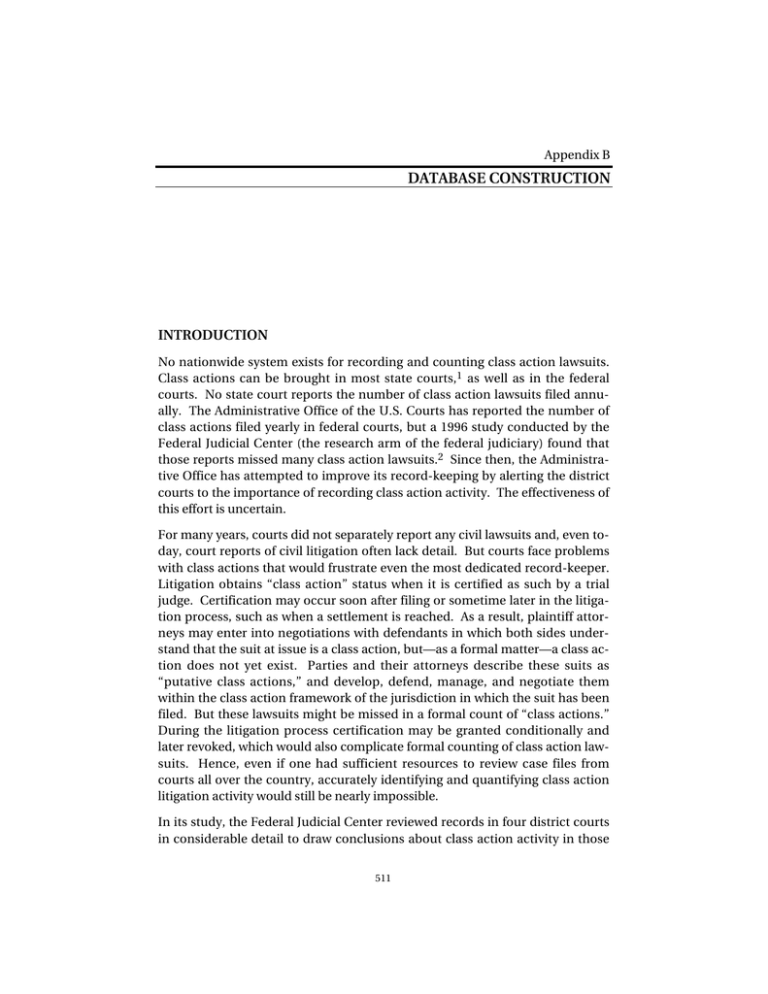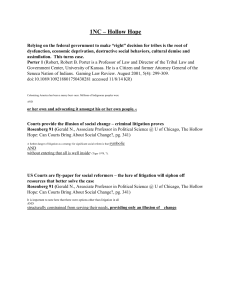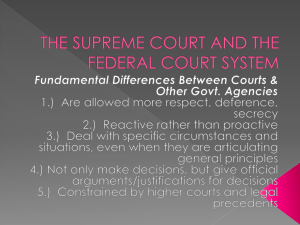DATABASE CONSTRUCTION INTRODUCTION
advertisement

Appendix B DATABASE CONSTRUCTION INTRODUCTION No nationwide system exists for recording and counting class action lawsuits. Class actions can be brought in most state courts,1 as well as in the federal courts. No state court reports the number of class action lawsuits filed annually. The Administrative Office of the U.S. Courts has reported the number of class actions filed yearly in federal courts, but a 1996 study conducted by the Federal Judicial Center (the research arm of the federal judiciary) found that those reports missed many class action lawsuits.2 Since then, the Administrative Office has attempted to improve its record-keeping by alerting the district courts to the importance of recording class action activity. The effectiveness of this effort is uncertain. For many years, courts did not separately report any civil lawsuits and, even today, court reports of civil litigation often lack detail. But courts face problems with class actions that would frustrate even the most dedicated record-keeper. Litigation obtains “class action” status when it is certified as such by a trial judge. Certification may occur soon after filing or sometime later in the litigation process, such as when a settlement is reached. As a result, plaintiff attorneys may enter into negotiations with defendants in which both sides understand that the suit at issue is a class action, but—as a formal matter—a class action does not yet exist. Parties and their attorneys describe these suits as “putative class actions,” and develop, defend, manage, and negotiate them within the class action framework of the jurisdiction in which the suit has been filed. But these lawsuits might be missed in a formal count of “class actions.” During the litigation process certification may be granted conditionally and later revoked, which would also complicate formal counting of class action lawsuits. Hence, even if one had sufficient resources to review case files from courts all over the country, accurately identifying and quantifying class action litigation activity would still be nearly impossible. In its study, the Federal Judicial Center reviewed records in four district courts in considerable detail to draw conclusions about class action activity in those 511 512 Class Action Dilemmas districts.3 Other empirical analyses have adopted similar, district-specific approaches to measuring class action activity. 4 We took a different approach, one that relied on specialized electronic data files to identify and describe class action activity nationwide. DATA SOURCES We used three sources of data: LEXIS, which reports federal and state appellate court opinions and selected federal district court decisions; NEXIS, which is an electronic library of newspapers, news magazines, and newsletters; and a business press database that comprises a subset of newspapers and periodicals of particular interest to the business community (also contained in NEXIS), plus the Wall Street Journal, which is available in a separate electronic data file. Reported judicial decisions appear in the national reporter system and in official state reporters for the states that have them. These collections are electronically accessible through LEXIS-NEXIS and Westlaw. The cases that appear in the official reporters do not constitute all cases decided by the courts. All decisions at the highest appellate level (e.g., the Supreme Court) in state and federal courts are reported. But not all decisions by the U.S. Courts of Appeals appear in the federal reporter, and only some opinions of state intermediate appellate courts appear in the state reporters. Typically, opinions of state trial court judges are not reported and only some federal trial court opinions are reported. As a consequence, the class action database we constructed using LEXIS represents primarily cases that generated controversy, leading to appeals to higher court levels; this database also disproportionately reflects activity in federal courts. The NEXIS electronic library contains 457 periodicals, including all major newspapers in the U.S. as well as regional and local papers from 43 of the 50 states. Class action litigation reported by the general press includes cases of local interest as well as lawsuits that are perceived to have broad economic or social consequences. Cases may be reported when they are filed, when newsworthy developments occur in the litigation, when they are tried to verdict or settled, or when an appellate court hands down an important decision. Sometimes the news reports do not indicate whether a case was filed in federal or state court, or describe its previous litigation history. The business database includes Business Week, Forbes, Fortune, Inc., the Reuters Business Report, and the Wall Street Journal, as well as other newspapers and periodicals targeted to the business community. Like other periodicals contained in NEXIS, these media report class action litigation at various stages of development and sometimes do not distinguish between federal and state law- Database Construction 513 suits. This database comprises lawsuits of special interest to business—e.g., securities class actions, mass product defect cases—as well as cases of general interest. Stories involving purely local cases are unlikely to appear. In sum, each database we constructed reflects a particular set of interests, and each sheds light only on a particular portion of the class action terrain. Because of differences in how the databases were constructed and in their underlying data sources, our combining them would be inappropriate. In Chapter Three, we therefore report the results of our analyses of the three databases separately. DATA SEARCH AND RETRIEVAL We searched each of the databases described above for two time periods: July 1, 1995–June 30, 1996, and July 1, 1996–June 30, 1997. Because of differences in our coding approach during the two periods, we report results separately for each year. Our first goal was to identify articles within each database that discussed specific class action lawsuits. This identification process required developing a computer search routine that would accurately locate all such articles while excluding articles not reporting class action activity. We could search all of the databases for content using alphanumeric search strings (i.e., alphabetic and numerical characters, words, and phrases) and Boolean logic connectors (i.e., “and” and “or”). We experimented with various search strings, but eventually adopted the term “class action” itself. Although searching with this term yielded a high percentage of irrelevant articles including many references to class action litigation generally, it ensured that we captured the largest proportion of articles and opinions that contained references to particular class action lawsuits. For the years of our search we found approximately 17,000 and 20,000 general press articles, respectively, on class action litigation, and much smaller numbers of articles and reported judicial opinions pertaining to class actions in the other two databases (see Table B.1). Table B.1 Number of Articles Number of Articles Source Reported judicial decisions General press Business press July 1, 1995–June 30, 1996 July 1, 1996–June 30, 1997 1,581 16,874 906 1,720 20,484 766 514 Class Action Dilemmas SAMPLING Because we identified such a large number of articles pertaining to class actions in the general press database, we selected a random sample of these articles for our research. We sampled 2000 articles for 1995–1996 and 1000 for 1996–1997. We coded all of the articles we identified from the two other databases without sampling. CODING After identifying relevant articles, we used a three-step coding process to extract information. First, we screened articles for content and separated those that reported on specific cases. This group of articles was the basis for our research. Second, we separated out those articles that reported high-profile class actions that were much in the news during this period: tobacco litigation, breast implant litigation, and asbestos litigation. Our analysis did not require us to code each of the many articles about these cases that appeared in the press during the study years. We developed a special coding approach for these high-profile cases. Third, for all other articles, we used a standardized coding form to extract information about the lawsuit mentioned, including case type, class size, party names, party type, state or federal court, geographic location, procedural status, and disposition. A copy of the coding form is included as Figure B.1. 5 Each article was coded by a staff member and checked by the coding supervisor, so that all articles were read twice. Any differences in opinion regarding the appropriate code were discussed and resolved, and additional training was provided as necessary. In addition, a small sample of articles was coded twice by coding staff members to ensure inter-coder consistency. DATA TRANSFORMATION The initial coded data pertained to articles rather than cases, creating the possibility that some cases would appear multiple times within the database. To describe the landscape of class action litigation, we needed to transform the database so that the unit of analysis would be a single lawsuit. To create case-specific records, we developed a computer program that compared plaintiff names, defendant names, case type, and forum state. When the computer identified matches of cases across articles, it created a single case record and extracted the relevant information about the case from the available articles. When the information in the coding forms was not sufficient to determine whether a case match existed, we reviewed the forms manually. Table B.2 presents the number of distinct cases that we identified from each database using this approach. Database Construction 515 Figure B.1—Class Action Coding Form 516 Class Action Dilemmas Figure B.1—(continued) Database Construction 517 Figure B.1—(continued) 518 Class Action Dilemmas Figure B.1—(continued) Database Construction 519 Table B.2 Number of Cases Number of Cases (unweighted) Source Reported judicial decisions General press Business press July 1, 1995–June 30, 1996 July 1, 1996–June 30, 1997 1,020 736 300 1,158 517 568 WEIGHTING THE GENERAL PRESS DATA Because we had sampled the general press in each of the two study years, we needed to weight the cases we extracted from this database to appropriately reflect the sampling rate. Because some cases generated more press coverage than others, we had to develop a weighting algorithm that took into account differential reporting of cases. In the equation below, W equals the sampling weight that we calculated for use in our analyses of the cases extracted from the general press database. N S × n W= P N= n= S= P= the number of articles in the population the number of articles in the sample the number of articles in the sample about a given case the number of articles in the population about a given case. The values of all variables in this equation, except for P, were determined by our coding procedure. We estimated P by performing additional analyses of the data set. Table B.3 shows the number of (weighted) cases for each of the databases we used for the analysis in Chapter Three. Table B.3 Number of Cases (Weighted) Number of Cases (weighted) Source Reported judicial decisions General press Business press July 1, 1995–June 30, 1996 July 1, 1996–June 30, 1997 1,581 3,000 906 1,720 6,000 766 520 Class Action Dilemmas COMPARISON WITH THE FEDERAL JUDICIAL CENTER STUDY DATA In its 1996 study, the Federal Judicial Center described class action lawsuits terminated in four federal district courts from July 1, 1992–June 30, 1994. The authors of the study graciously provided us with the data, which enabled us to RANDMR969.B.2 Federal Judicial Center Securities Securities Consumer California (North) (N=102) Consumer Illinois (North) (N=116) Torts Employment Torts Employment Civil rights Civil rights Benefits, taxes, other govt. Benefits, taxes, other govt. Securities Securities Consumer Florida (North) (N=72) Consumer Pennsylvania (East) (N=117) Torts Employment Torts Employment Civil rights Civil rights Benefits, taxes, other govt. 0 10 20 30 Benefits, taxes, other govt. 40 0 Percent of cases 10 20 30 40 Percent of cases RAND/ICJ Securities Securities Consumer Consumer General Press (N=3080) Torts LEXIS (N=1036) Employment Torts Employment Civil rights Civil rights Benefits, taxes, other govt. Benefits, taxes, other govt. Securities 0 Business Press (N=303) 10 20 30 Percent of cases Consumer Torts Employment Civil rights Benefits, taxes, other govt. 0 10 20 30 40 Percent of cases Figure B.2—Comparison of Federal Judicial Center Data and RAND/ICJ Data 40 Database Construction 521 categorize the lawsuits according to the scheme we used for coding cases in our database. Figure B.2 compares the FJC data and the data we collected for this study. There are a number of explanations for the differences between the FJC study data and our own. First, differences exist in the scope of the two studies: The FJC study was limited to four federal district courts, whereas our study reflects the nationwide population of class actions, including class actions brought in state courts. Second, the FJC study identified and described class action lawsuits from court records. Our study relies on less inclusive appellate decisions and more inclusive but less precise newspaper reports. Third, the FJC study identified cases terminated in 1992–1994, some of which were filed years earlier. Our study captures class actions in process during 1995–1996, which include newly filed and terminated lawsuits as well as cases still pending. NOTES 1See Thomas Dickerson, Class Actions: The Law of 50 States (New York: Law Journal SeminarsPress, 1997). 2Thomas Willging, Laural Hooper, and Robert Niemic, Empirical Study of Class Actions in Four Federal District Courts: Final Report to the Advisory Committee on Civil Rules (Washington, D.C.: Federal Judicial Center, 1996). 3Id. 4 See discussion in Chapter Two, supra at 18. 5We used an abbreviated form to code judicial opinions, and a still more abbreviated version to code articles selected for the second study year. By the second coding, we had determined that much of the information we sought in the original protocol could not be obtained from a sufficient number of articles to make collecting it worthwhile.





